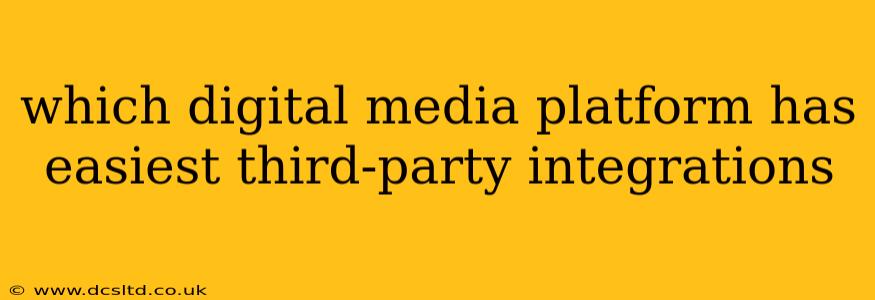Choosing the right digital media platform hinges on many factors, but ease of third-party integration is a major one. Seamless integration streamlines workflows, boosts efficiency, and unlocks a wider range of functionalities. While "easiest" is subjective and depends on your specific needs and technical expertise, some platforms consistently stand out for their user-friendly integration capabilities. This article will explore several leading platforms and delve into what makes their integration processes relatively straightforward.
What Makes Third-Party Integrations Easy?
Before we dive into specific platforms, let's clarify what constitutes easy integration. Several key factors contribute:
- Robust API: A well-documented and comprehensive Application Programming Interface (API) is crucial. A strong API allows developers to easily connect their chosen tools and services.
- Pre-built Integrations: Many platforms offer pre-built integrations with popular tools, eliminating the need for custom development. This dramatically simplifies the process.
- Intuitive User Interface: A user-friendly interface, whether for connecting integrations or managing them, significantly impacts the ease of use.
- Comprehensive Documentation: Clear and comprehensive documentation, including tutorials and examples, is essential for both technical and non-technical users.
- Active Community Support: A strong community forum or support system can provide quick answers to questions and help troubleshoot integration issues.
Platforms with Relatively Easy Third-Party Integrations
Several platforms generally receive praise for their integration capabilities. The "easiest" will vary based on individual needs, but these consistently rank highly:
1. Zapier: While not a media platform itself, Zapier acts as a powerful intermediary, connecting numerous platforms, including many digital media platforms. Its visual interface and extensive pre-built integrations make it incredibly user-friendly, even for non-developers. Many digital media platforms seamlessly integrate with Zapier, making it a great option for simplifying complex workflows.
2. HubSpot: HubSpot's marketing hub boasts an extensive array of integrations, many specifically designed for streamlining media workflows. It offers a robust API and a large library of pre-built integrations, making it a solid choice for businesses looking for centralized management of their marketing and media efforts. Its intuitive interface contributes to its ease of use.
3. WordPress: While primarily a content management system (CMS), WordPress's vast plugin ecosystem provides near-limitless integration possibilities. Countless plugins are available, connecting WordPress websites to various social media platforms, marketing automation tools, and other services. This ease of extending functionality makes it a popular choice among businesses using it as their central digital media platform.
H2: What are some common third-party integrations for digital media platforms?
Common third-party integrations for digital media platforms frequently include:
- Social Media Management Tools: Platforms like Hootsuite, Buffer, and Sprout Social seamlessly integrate to streamline social media posting and monitoring.
- Email Marketing Platforms: Mailchimp, Constant Contact, and others integrate to manage email campaigns effectively.
- Analytics Platforms: Google Analytics, among others, integrate to track performance metrics crucial to digital media strategies.
- CRM Systems: Salesforce, HubSpot CRM, and similar systems integrate to manage customer relationships and track interactions.
- Design and Editing Tools: Adobe Creative Cloud, Canva, and similar tools integrate for creating engaging visual content.
H2: How do I choose the right third-party integration for my needs?
Selecting the right integration involves careful consideration:
- Functionality: Identify your specific needs and the tasks you want to automate or improve.
- Platform Compatibility: Ensure the integration is compatible with your chosen digital media platform(s).
- Cost: Evaluate the pricing model—some integrations are free, while others charge based on usage or features.
- Ease of Use: Prioritize integrations with user-friendly interfaces and comprehensive documentation.
- Support: Choose integrations with reliable customer support to resolve any issues promptly.
H2: Are there any security considerations when using third-party integrations?
Security is paramount when integrating third-party tools. Consider:
- Reputation and Security Practices: Choose reputable providers with strong security measures in place.
- Data Privacy: Review the integration's data privacy policy to ensure it aligns with your requirements.
- Access Control: Implement appropriate access controls to restrict access to sensitive data.
- Regular Updates: Keep your integrations updated to benefit from security patches and bug fixes.
Ultimately, the "easiest" digital media platform for third-party integrations depends heavily on your specific requirements and technical skills. However, by considering the factors discussed above and exploring the popular platforms highlighted, you can significantly enhance your workflow and unlock the full potential of your digital media strategy.
